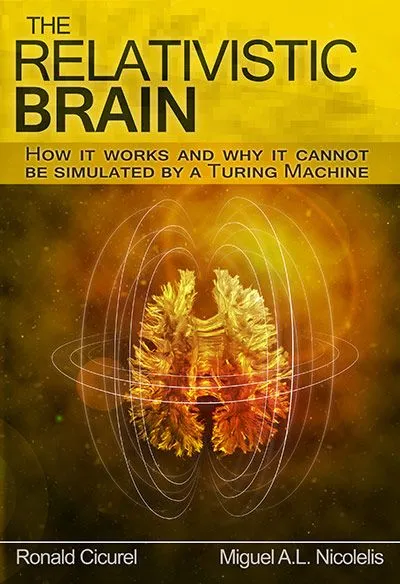Reading: The Relativistic Brain: How It Works and Why It Cannot by Simulated by a Turing Machine by Ronald Cicurel and Miguel A. L. Nicolelis - Parts 1&2


This was first posted as part 1 & 2 on substack.
Ronald Cicurel, and Miguel A. L. Nicolelis, The Relativistic Brain: How It Works and Why It Cannot by Simulated by a Turing Machine (Natal: Kios Press, 2015 ISBN 9781511617024) Hat tip. Martin Ciupa of mindmaze.com
At the time of writing in July 2023, there were some Douglas R. Hofstadter interviews passing my notice. It was great to watch him speak for the first time (for me) as his famous “GEB” had a large affect on my later teenage years. He mentions that he put ideas together in the later I am in a strange loop better, but I still haven’t read it it, even though I have clear memories of handling copies in bookstores and bookshops, decades ago. I discovered Hofstadter The Mind's I for Christmas (1982-3?) I received from my parents.
At one stage I was all set to go back to study at university with a neuro-psychology track in mind, but this got de-railed by helping to set up the Tip Shops, and some other co-operatives. These days we would call that being involved in a “start-up”.
This preamble explains why I was excited to read The Relativistic Brain: How It Works and Why It Cannot by Simulated by a Turing Machine.

Now, watching that interview Hofstadter describes a position which I noticed differed from mine slightly, even though I developed it reading his books. He was slightly more reductionist than me, or, more wary of holistic excuses, if we can put it like that.
Suspicious of emergence as a hand-waving gap filler I guess.
So the key thing to know for me now reading The Relativistic Brain is that it attempts to test a gap-filler (created when I read Gödel, Escher, Bach: an Eternal Golden Braid). For in GEB Hofstadter describes the process by which Turing creates the framework for the turing machine (computers) as a internal notice of Turing’s in which he creates a numbered list of how he does this work, in his mind’s eye, of the effort of logic or mathematics as a series of steps, and how that is mapped into some mechanical (later electrical) device. I.E the algorithm made metal, or wood, or silicon. The LLMs that can chat with us, where we’ve stripped out up one element of our consciousness and boosted that into artificial intelligence, as it is the best we have currently as “A.I.”.
Hofstadter points out (in the 1970s) that this serial process arises and is noticed and is reported/produced on/in a parallel wetware body. The outcome is not the source. The faeces is not the gut, let alone a meal with friends and enemies, family and strangers, gut biota and parasites. The brain is more than the sum of its recorded speech, however carefully delineated. This is why I say logic is a hindsight.
So the gap here is what about the rest of the “brain”. What about those non-parallel processes? Can we just label them as holistic mysteries and move on into dogma? Or can we begin to test whole effects in the brain, by the brain and me: the brain as gland, the hum of membranes, the glow of…
In this monograph, a mathematician and a neurobiologist join forces to address one of the most crucial and controversial scientific questions of our times: can the exquisite capacities of the human brain be simulated by any digital computer? By combining mathematical, computational, neurobiological and evolutionary arguments, Ronald Cicurel and Miguel Nicolelis refute the possibility that any Turing machine will ever succeed in such a simulation. As part of their argument, the authors propose a new theory for brain function: the Relativistic Brain Theory. This theory accounts for decades of neurophysiological and psychological findings and observations that until now have challenged the dominant dogma in neuroscience. Altogether, this monograph contains the inaugural manifesto of a movement intended to emphasize the uniqueness of human nature while discrediting pseudo-scientific predictions that the replacement of humans by machines is imminent. In the authors' opinion, the misguided and misleading belief that digital machines can emulate all human behaviors defines one of the greatest threats that society faces in the future to preserve our way of life, our human culture and our freedom. (blurb for The Relativistic Brain)
When I am half way reading through the book, it argues that the other processes at work in consciousness are large scale electromagnetic continuums in dialogue with more “digital” nitty gritty of neuronal signalling. I explain that more in a post when I have read the whole book.
Here are some (non)poetic possible predictions or notes while reading up to page 40 or so:
To have a world
is to have a soul.
When we die the world departs us,
long live the world.
The world is a phantom limb we inhabit.
The soul is a proprioceptive shift into the world,
probing, mistepping, re-worlding.
The world is the same as the self or soul, predicting,
but is the remainder of not-self…
—not predicting and testing.Worldbuilding/worldbuilding by us worldren is a function of the brain we often collectivise and lump together holisitically, as we feel we should, when we should.
Worldbuilding/worldbuilding by us worldren is an aspect of conciousness we don't claim as our own soul, thus our souls can be colonised by narcissists and psychopaths (in giving narcisstic supply).
Worldbuilding/worldbuilding by us worldren in stuff is the same as self or soul but is that which is not-self in the sense or practicality of that which is predicted and tested. Imperial religions try to turn that world/soul dynamic into command and obedience. A world of order, where “logic is hindsight” is all there is.
(Is this the reason electro-libertarians, the tech bros, think they can become transhuman by counting backwards better?)
Prophets are a pathology. Prophets are a diagnistic symptom of things/world/soul gone-going bad.
Second part

The relativism of the book title refers to ‘processes’ in addition to more computational aspects of neuronal behaviour (and from which we form more mechanical and formally logical connections, and from this powerful hindsight digital computing is produced a rarefied pacticality, theTuring machine.
These ‘processes’ form a continuum, analogous only to a space-time continuum, so the metaphor here is some set of relations yet to be determined. The relatvity is unknown even is we are the output of this mess.
In the book, besides the listing of caveats on computational brains not being the whole picture, and the complaints of the waste of resources in AI & human brain research which do not look beyond pure computational models, there is thus a useful listing and critique of other non- or extra- computational theories of human/animal consciouness.
So, what is their theory or hypothesis about this processes?
Some interaction of (at the macro-level of the hum) of electro-magnetic activity of the brain which forms a continuum with more neuronal signalling in more computational forms, in which time cannot be excluded.
They argue a lot of brain function is non-localised (if not acutally global, if not holistic or emergent, these are not necessary to the theory) so how do we explain that with purely computational strategems?
Their hypothesis is potentially testable, I think, but unfashionable in the main markets available to us.
In current computing, whether serial computers, or more like parrallel computing, or, I guess even photonic computers using memristors and quantum mechanics or not, and even in these more analog computing attempts (—or straight quantum computing… —? no idea), the closest we get to this is the interference called parasitic capacitance between bits of circutry, and this is unwanted and engineered out or allowed for and ignored.
Did evolution use this interference to create consciouness? The sensitivity to sensitivities, does this successfully leap the gap and loop us back into ourselves as worldings?
I was expecting to world more words, but no, a parasitic reference is enough it seems.
So in looping the leap, I’ll just repeat that: the world and the self are both delusions of consciousness however this thing is become…. —so/but I do not know who is fooling who.
